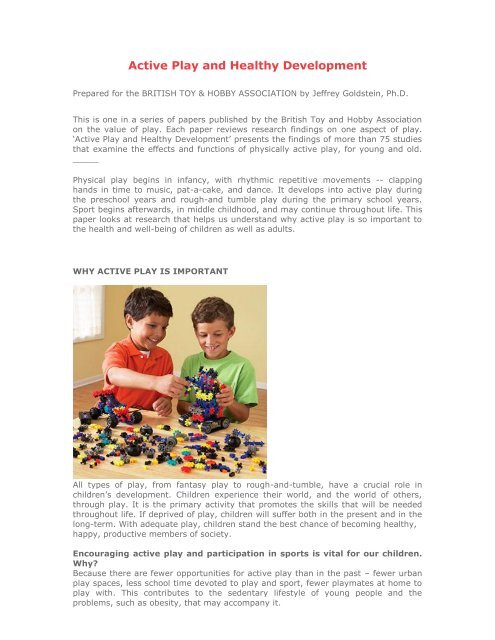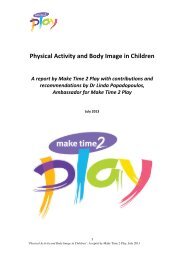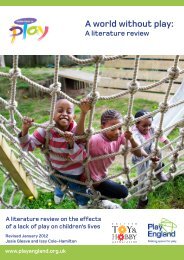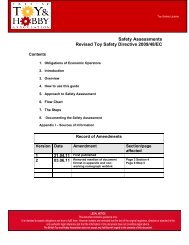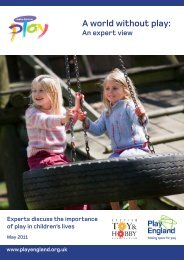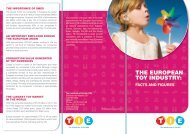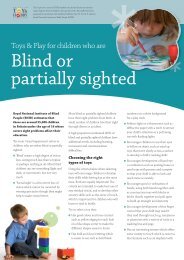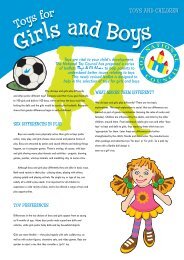Active Play and Healthy Development - British Toy & Hobby ...
Active Play and Healthy Development - British Toy & Hobby ...
Active Play and Healthy Development - British Toy & Hobby ...
Create successful ePaper yourself
Turn your PDF publications into a flip-book with our unique Google optimized e-Paper software.
<strong>Active</strong> <strong>Play</strong> <strong>and</strong> <strong>Healthy</strong> <strong>Development</strong>Prepared for the BRITISH TOY & HOBBY ASSOCIATION by Jeffrey Goldstein, Ph.D.This is one in a series of papers published by the <strong>British</strong> <strong>Toy</strong> <strong>and</strong> <strong>Hobby</strong> Associationon the value of play. Each paper reviews research findings on one aspect of play.‘<strong>Active</strong> <strong>Play</strong> <strong>and</strong> <strong>Healthy</strong> <strong>Development</strong>’ presents the findings of more than 75 studiesthat examine the effects <strong>and</strong> functions of physically active play, for young <strong>and</strong> old._____Physical play begins in infancy, with rhythmic repetitive movements -- clappingh<strong>and</strong>s in time to music, pat-a-cake, <strong>and</strong> dance. It develops into active play duringthe preschool years <strong>and</strong> rough-<strong>and</strong> tumble play during the primary school years.Sport begins afterwards, in middle childhood, <strong>and</strong> may continue throughout life. Thispaper looks at research that helps us underst<strong>and</strong> why active play is so important tothe health <strong>and</strong> well-being of children as well as adults.WHY ACTIVE PLAY IS IMPORTANTAll types of play, from fantasy play to rough-<strong>and</strong>-tumble, have a crucial role inchildren’s development. Children experience their world, <strong>and</strong> the world of others,through play. It is the primary activity that promotes the skills that will be neededthroughout life. If deprived of play, children will suffer both in the present <strong>and</strong> in thelong-term. With adequate play, children st<strong>and</strong> the best chance of becoming healthy,happy, productive members of society.Encouraging active play <strong>and</strong> participation in sports is vital for our children.Why?Because there are fewer opportunities for active play than in the past – fewer urbanplay spaces, less school time devoted to play <strong>and</strong> sport, fewer playmates at home toplay with. This contributes to the sedentary lifestyle of young people <strong>and</strong> theproblems, such as obesity, that may accompany it.
<strong>Active</strong> play has immediate benefits, such as cardiovascular fitness, <strong>and</strong> longtermbenefits, including a healthy lifestyle <strong>and</strong> better physical, intellectual <strong>and</strong>social skills<strong>Play</strong> develops the brainPhysically active play improves muscle control <strong>and</strong> co-ordination, strength<strong>and</strong> endurance, <strong>and</strong> may promote fat reduction <strong>and</strong> body temperatureregulation<strong>Play</strong> is an effective teaching strategy both in school <strong>and</strong> outGiven the space <strong>and</strong> resources, children enhance their physical development throughplay that draws upon bodily movement <strong>and</strong> control. They build muscle strength <strong>and</strong>can develop habits <strong>and</strong> interests that form the basis for a healthy lifestyle. Childrenonly become “couch potatoes” when adults restrict their activity, limit their access tooutdoor play <strong>and</strong> allow children to spend excessive time on “screen play” with atelevision or computer. -- What is play? Children’s <strong>Play</strong> Information Service. 2002.www.ncb.org.uk<strong>Play</strong>ful children are popular <strong>and</strong> happy<strong>Active</strong> play is not just about physical growth <strong>and</strong> development but also builds selfconfidence<strong>and</strong> social skills. In one study, young people aged 12 to 22 years whoregularly engaged in vigorous physical play were found to be less shy than others.Those who participated in team sports scored lowest on a measure of shyness (Page& Zarco, 2001). In a study of girls 9 to 13 years old, those who engaged in regularphysical activities had higher self-esteem (Schmalz, et al., 2007).<strong>Play</strong>ful children are happier, better adjusted, more co-operative, <strong>and</strong> more popularwith their peers than those who play less. ‘Children play longer when a wide varietyof toys is available. <strong>Play</strong>ful children are more physically active, creative, humorous,imaginative, emotionally expressive, curious <strong>and</strong> communicative’. -- Jerome Singer.1994. Imaginative play <strong>and</strong> adaptive development.
Motor skills<strong>Play</strong> is a form of exercise that increases co-ordination, flexibility, <strong>and</strong> precision inmovement. Infants <strong>and</strong> toddlers first explore objects to become familiar with them,<strong>and</strong> as mastery is achieved, they play with objects in lighthearted ways. Physicalfeatures of toys, particularly their novelty <strong>and</strong> responsiveness to the child’smovements, influence interest <strong>and</strong> duration of play.ExplorationThe ability to sustain attention to objects, events, <strong>and</strong> tasks is important for manykinds of learning <strong>and</strong> performance. Attention span during play depends almost solelyon the type <strong>and</strong> number of toys available (Moyer & Gilmore, 1955).Before about age 1 children’s attention is determined by the colour, size, shape <strong>and</strong>taste of objects. Bright colours <strong>and</strong> gentle sounds hold their attention. The physicalfeatures of toys, particularly their novelty <strong>and</strong> responsiveness to the child’smovements, influence interest <strong>and</strong> duration of play.Co-ordinationEven in reaching for a toy, a baby develops h<strong>and</strong>-eye co-ordination, strength,balance <strong>and</strong> agility – skills necessary for walking <strong>and</strong> all other movement. Activitycentres, block letters, shape sorters, <strong>and</strong> games help children acquire skillsnecessary for language <strong>and</strong> reading. <strong>Play</strong> involving brisk movement is related to thedevelopment of a wide variety of physical skills, including those involved in sports(Bunker, 1991).Children need to attain the following motor skills:Locomotor, or gross motor, development involves large movement patterns,such as walking, running, jumping, hopping, skipping, sliding, climbing,crawling, st<strong>and</strong>ing, sittingMaintaining equilibrium <strong>and</strong> balance, such as bending, stretching, twisting,pivoting, swinging, rolling, l<strong>and</strong>ing, stopping, dodging, balancingManipulative or fine motor skills <strong>and</strong> h<strong>and</strong>-eye <strong>and</strong> foot-eye coordinationskills, such as throwing, catching, kicking, volleying, bouncing, rolling, pulling,pushing, grasping, reaching, holding, cutting, typing, writing, drawing,painting. -- Helen Bilton. <strong>Play</strong>ing outside. 2004. p. 32Physical activity can influence 8 components of physical fitness: agility, balance,amount of body fat, cardio-respiratory endurance, flexibility, muscular endurance,muscular strength, <strong>and</strong> anaerobic power. -- Baranowski, <strong>and</strong> others. 1992.Assessment, prevalence, <strong>and</strong> cardiovascular benefits of physical activity <strong>and</strong> fitnessinyouth.Rough-<strong>and</strong>-tumble playRough-<strong>and</strong>-tumble (R & T) may be the most fundamental form of active play. R&Tincludes running, chasing, play wrestling, <strong>and</strong> often lots of noise. It is unique <strong>and</strong> canbe readily distinguished from aggression. In other words, aggressive play is not thesame as aggressive behaviour. You can usually tell rough-<strong>and</strong>-tumble play fromgenuine fighting. In rough-<strong>and</strong>-tumble, children will be smiling <strong>and</strong> laughing, <strong>and</strong>they will remain together once they’re finished playing. Children who are reallyfighting will separate once the fight is over. (Reed 2005).‘Professionals need to be careful not to equate play-fighting with serious fighting <strong>and</strong>not to label a child as “aggressive” simply because he or she prefers a particular kindof play. Given many children’s interest <strong>and</strong> enjoyment in active, locomotor (physical)
play, children should be given numerous opportunities for this type of play as well.Such activities likely contribute to motor development, overall physical fitness <strong>and</strong>possibly cognitive development’. -- Power. ‘<strong>Play</strong> <strong>and</strong> exploration in children <strong>and</strong>animals’. p.395.R & T usually involves playing with others <strong>and</strong> is related to social skills, status <strong>and</strong>emotional control (Pellegrini & Smith 1998; Reed 2005). This kind of active play,especially outdoors, burns more calories than other forms of play. R&T is not just aphysical release, it also ‘may facilitate friendships <strong>and</strong> promote co-operativeprosocial behaviours <strong>and</strong> attitudes’ (Scott & Panksepp, 2003, p. 549).<strong>Active</strong> free play can lead to improved academic performanceOne study shows that providing primary school children with play breaks during theschool day maximises their attention to cognitive tasks. Without play, self-controldoes not develop adequately. Research by Anthony Pellegrini <strong>and</strong> Robyn Holmesshows that providing children with play breaks during the school day maximises theirattention to cognitive tasks. ‘<strong>Play</strong> affords juveniles opportunities to learn <strong>and</strong> practicenew skills. The more complex the organism <strong>and</strong> the corresponding skills to belearned, the longer the juvenile period is extended <strong>and</strong> the more important playseems to be’ (Pellegrini & Holmes 2006).In a study of two fourth-grade classes in a suburban school, when students hadrecess they were less fidgety <strong>and</strong> stayed on task longer in class. (Jarrett, <strong>and</strong> others,2001).Competent play is related to early school performance, while disruptive play isassociated with difficulties at school. By the time children attend preschool, theyshould already have experience playing at home with peers. Relationships betweenparental reports of children's peer play at home <strong>and</strong> indicators of children's schoolreadiness were examined in a study by Fantuzzo. Behaviour ratings <strong>and</strong>observational data were collected for 242 preschool children from a large urban HeadStart programme. Relationships between children's home-based, peer-playbehaviours <strong>and</strong> the children's classroom behaviours (school-based peer play,approaches to learning, self-regulation, <strong>and</strong> behaviour problems) were analysed.<strong>Play</strong> competence exhibited in the home environment was significantly associatedwith helping in the classroom, motivation to learn, task persistence, <strong>and</strong> autonomy.Disruptive or disconnected play behaviours were significantly related to patterns ofdisruptive experiences in the classroom with peers <strong>and</strong> with the learning process(Fantuzzo, 2002).Creativity increases following free playChildren produced more colourful <strong>and</strong> complex art after being allowed to play,compared to children who first followed a structured exercise. Fifty-two Englishschool children 6 to 7 years old were r<strong>and</strong>omly assigned to two groups. The firstgroup was allowed to play for 25 minutes, while the other group copied text from theboard. All children were then asked to produce a collage of a creature, using alimited range of tissue-paper materials. Ten judges assessed the creative quality ofthe resulting work. The range of colours <strong>and</strong> total number of pieces used by eachchild was recorded. The results revealed a significant positive effect of unstructuredplay upon creativity. -- Howard-Jones & others. 2002. The effect of play on thecreativity of young children during subsequent activity.<strong>Play</strong> <strong>and</strong> emotion
In one study, 44 preschool children (22 boys, 22 girls) were interviewed about theirunderst<strong>and</strong>ing of emotion. In addition, the amount of children's pretend <strong>and</strong> physicalplay with a same-sex friend from their preschool classroom was assessed. Findingssuggest that emotion regulation <strong>and</strong> emotion underst<strong>and</strong>ing (part of what is meantby ‘emotional intelligence’) make unique contributions to teacher ratings of children'semotional competence with peers. Different patterns of associations were found forboys <strong>and</strong> girls. High levels of pretend play were associated with greater emotionalunderst<strong>and</strong>ing for both boys <strong>and</strong> girls, <strong>and</strong> with grater emotion regulation <strong>and</strong>emotional competence for girls. Physical play was associated with boys' emotionalcompetence with peers (Lindsey & Colwell, 2003). Preschoolers' emotionalcompetence: Links to pretend <strong>and</strong> physical play.Impulse control (emotional self-regulation)Fantasy play allows children to work through conflict <strong>and</strong> painful feelings. In play,children learn how <strong>and</strong> when to express or control their emotions. Even play fightingrequires a good deal of self-control <strong>and</strong> restraint, serving as practice for exercisingrestraint in more serious contexts (Power 2000, Galyer & Evans 2001).<strong>Active</strong> play <strong>and</strong> risk-taking‘Risk-taking is a powerful way of learning. When we take a risk, we face success orfailure. Success raises our self-esteem. Failure may hurt, but it teaches us to dothings differently next time. Children need to learn to make sensible choices as theyget older <strong>and</strong> sometimes this takes a few mistakes...Of course adults need to limitthe risks children take to prevent serious injuries. Ideally, though, we shouldn'tremove risks completely. We can't prevent every injury, <strong>and</strong> minor ones can be auseful learning experience, after all’. -- BBChttp://www.bbc.co.uk/schools/parents/life/health_happiness/health/play_fighting.shtml accessed 8 Nov 07If you make an environment hazard free it becomes challenge free, <strong>and</strong> then‘children have less experience in making decisions on their own, less opportunity toassess their own personal frontiers <strong>and</strong> less opportunity to gain confidence <strong>and</strong> selfesteemthrough coping independently’. -- Stephenson. 2003. Physical risk-taking:Dangerous or endangered? (see also Gill 2007.)Even children under 2 take on considerable physical challenges: negotiating steps,transporting materials, climbing into a swing, managing to make a bike move,running. These “risky” activities extend children’s physical prowess <strong>and</strong>independence. ‘Too often the concern to remove all hazards from a playground caninadvertently also lead to the removal of all opportunities for risk-taking’, writesStephenson (p. 35).Risk taking as a form of intelligent behaviourAccording to one psychologist, ‘Intelligent people seem to have an almostuncontrollable urge to go beyond established limits <strong>and</strong> creative people seemcompelled to place themselves in situations where they don’t know what is going tohappen. They accept confusion, uncertainty, <strong>and</strong> the higher risks of failure as part ofthe process <strong>and</strong> learn to view failure as normal, even interesting <strong>and</strong>challenging’(Costa, 1991, p. 41).Stephenson writes, ‘the discourses that surround us tend to focus on the “darker”side of risk – seeing the uncertainty, the possibility of failure, of injury. As teachers,however, it is important that we ensure that the positive aspects of risk are also
acknowledged – the possibility of discovering that one is adventurous, daring, brave,strong, confident <strong>and</strong> successful’ (p. 42).(See Table 1.)Table 1. Some skills developed through physically active playMotor skillso balanceo coordinationo flexibilityo enduranceo strengtho agilityCognitive / intellectual development:o attentiono problem solvingo creativityo goal-settingo exploration <strong>and</strong> discoveryo manipulationEmotional developmento self-regulation of emotiono curiosityo taking measured risksSocial development. When playing with others:o children must communicate clearly to one anothero they must cooperate on the basic elements of play, such as sharing<strong>and</strong> taking turnPLAY AND HEALTH<strong>Active</strong> play is continually limited by diminishing public space for play <strong>and</strong> sports, <strong>and</strong>reduced opportunities for outdoor <strong>and</strong> social play. This contributes to the sedentarylifestyle of young people <strong>and</strong> the problems, such as obesity, that accompany it.Encouraging active play <strong>and</strong> participation in sport thus becomes of vital importance.
<strong>Play</strong> develops the brain<strong>Play</strong> theorist Brian Sutton-Smith believes that the human child is born with a hugeneuronal over-capacity, which if not used will die. ‘Not only are children developingthe neurological foundations that will enable problem solving, language <strong>and</strong>creativity, they are also learning while they are playing. They are learning how torelate to others, how to calibrate their muscles <strong>and</strong> bodies <strong>and</strong> how to think inabstract terms. Through their play children learn how to learn. What is acquiredthrough play is not specific information but a general mind set towards solvingproblems that includes both abstraction <strong>and</strong> combinatorial flexibility where childrenstring bits of behaviour together to form novel solutions to problems requiring therestructuring of thought or action’. -- Sutton-Smith. 1997. The Ambiguity of <strong>Play</strong>.<strong>Play</strong> influences neurological development <strong>and</strong> determines how intricate neuralcircuits are wired. Among other research, positron-emission tomography scans ofRomanian orphans with play deprivation indicate that play is as essential to hum<strong>and</strong>evelopment as other basic needs. -- S. Begley, 1997. How to build a baby’s brain.According to a report by the American Academy of Pediatrics, “<strong>Play</strong> is essential todevelopment because it contributes to the cognitive, physical, social, <strong>and</strong> emotionalwell-being of children <strong>and</strong> youth. <strong>Play</strong> also offers an ideal opportunity for parents toengage fully with their children. Despite the benefits derived from play for bothchildren <strong>and</strong> parents, time for free play has been markedly reduced for somechildren.” -- K. Ginsberg <strong>and</strong> others. 2007. The importance of play in promotinghealthy child development <strong>and</strong> maintaining strong parent-child bonds.<strong>Toy</strong> play at age 18 months is related to the child’s intelligence at age 3years<strong>Play</strong>ful children are happier, better adjusted, more co-operative, <strong>and</strong> more popularwith their peers than those who play less. Children play longer when a wide varietyof toys are available. In one study, the availability of toys in infancy was related tothe child’s IQ at 3 years of age. Children with access to a variety of toys are found toreach higher levels of intellectual achievement, regardless of the children’s sex, race,or social class. -- Elardo <strong>and</strong> others. 1975. The relation of infants’ homeenvironments to mental test performance from 6 to 36 months. Bradley. 1985. <strong>Play</strong>materials <strong>and</strong> intellectual development.Girls who engage in active play as children are more likely later to be involved insport (Giuliano, Popp, & Knight, 2000).Exercise for the brainComputer programs to improve brain performance are a booming business. Theseproducts are often said to be based on scientific research. To be charitable, we mightcall them inspired by science — not to be confused with actually proven by science.‘One form of training, however, has been shown to maintain <strong>and</strong> improve brainhealth — physical exercise. Exercise improves what scientists call “executivefunction,” the set of abilities that allows you to select behaviour that’s appropriate tothe situation, inhibit inappropriate behaviour <strong>and</strong> focus on the job at h<strong>and</strong> in spite ofdistractions’, write Aamodt <strong>and</strong> Wang, a professor of molecular biology. Executivefunction includes basic processes like response speed <strong>and</strong> memory. Executivefunction starts to decline when people reach their 70s. But elderly people who havebeen athletic all their lives have much better executive function than sedentarypeople of the same age.Exercise is also strongly associated with a reduced risk of dementia late in life.People who exercise regularly in middle age are one-third less likely to get
Alzheimer’s disease in their 70s as those who did not exercise. Even people whobegin exercising in their 60s reduce their risk significantly (Aamodt & Wang 2007).How might exercise help the brain? Fitness training slows the age-related shrinkageof the frontal cortex, which is important for executive function. In animals, exerciseincreases the number of capillaries in the brain, which should improve blood flow,<strong>and</strong> therefore the availability of energy, to neurons. Exercise may also help the brainby improving cardiovascular health, preventing heart attacks <strong>and</strong> strokes that cancause brain damage. Finally, exercise causes the release of growth factors, proteinsthat increase the number of connections between neurons, <strong>and</strong> the birth of neuronsin the hippocampus, a brain region important for memory. Any of these effects mightimprove cognitive performance, though it’s not known which ones are mostimportant. -- Aamodt & Wang. 2007. Exercise for the brain.Functions of physical play include motor control, strength <strong>and</strong> endurance,<strong>and</strong> self-regulation of emotionsPellegrini <strong>and</strong> Smith consider the nature of physically active play <strong>and</strong> its possible rolein children’s development. They distinguish three kinds of physical activity play:rhythmic movements peaking in infancy, exercise play peaking during the preschoolyears, <strong>and</strong> rough-<strong>and</strong>-tumble play which reaches its peak in middle childhood.Gender differences (greater prevalence in males) characterise the latter two forms.Function is considered in terms of beneficial immediate <strong>and</strong> deferred consequences inphysical, cognitive, <strong>and</strong> social domains. Whereas most theories assume thatchildren's play has deferred benefits, Pellegrini <strong>and</strong> Smith suggest that forms ofphysical activity play serve primarily immediate developmental functions. Repetitiverhythmic movements in infancy are hypothesised to improve control of specific motorpatterns. Exercise play is hypothesised to function primarily for strength <strong>and</strong>endurance training; less clear evidence exists for possible benefits for fat reduction<strong>and</strong> thermoregulation. In addition, there may be cognitive benefits of exercise playthat are largely incidental to its playful or physical nature. Rough-<strong>and</strong>-tumble playhas a distinctive social component; it serves primarily dominance functions; evidencefor benefits to fighting skills or to emotional coding are more equivocal. -- AnthonyPellegrini & Peter K. Smith. 1998. Physical activity play.<strong>Play</strong> has immediate benefits, such as cardiovascular fitness, <strong>and</strong> long-termbenefits, including a sense of moralityAn article in the American Psychological Association Monitor on Psychology examinesthe positive effects <strong>and</strong> utter necessity of play. The most common theory is thatjuveniles play at the skills they will need as adults. Some newer thinking proposes itis more than that. <strong>Play</strong> seems to have some immediate benefits, such as aerobicconditioning <strong>and</strong> fine-tuning motor skills, as well as long-term benefits that includepreparing young animals for the unexpected <strong>and</strong> giving them a sense of morality.How? ‘Through rough <strong>and</strong> tumble play, animals form social bonds, acquire differentdominance ranks <strong>and</strong> learn what behaviours are acceptable: how hard they can bite,how roughly they can interact, <strong>and</strong> how to resolve conflicts’. They learn ‘right’ from‘wrong’. (Azar 2002).If obesity is the problem, play may be the solutionObesity is more than just a cosmetic concern. Short- <strong>and</strong> long-term physical <strong>and</strong>psychological problems can result from childhood obesity, which has been linked toshorter life spans <strong>and</strong> a number of health factors including diabetes, cardiovasculardisease, high blood pressure, stress on bones <strong>and</strong> lungs, high cholesterol, jointdisease, irregular menstrual cycles <strong>and</strong> stroke. Furthermore, obese children are often
teased <strong>and</strong> psychological effects can include feelings of inadequacy, low self-esteem<strong>and</strong> embarrassment. When these children become obese adults, they are oftendiscriminated against <strong>and</strong> have difficulties in finding jobs <strong>and</strong> establishingrelationships.Childhood obesity results from genetics, the environment, including parentalexample, emotional instability, hormone levels <strong>and</strong> also intake-activity relationships.For the majority of people involved with children, the intake-activity relationship isthe only factor they can reasonably influence. Increasing the physical activity levelamong children is complicated. Schools, under pressure to increase test scores, aredecreasing children’s opportunities to participate in break periods <strong>and</strong> physicaleducation. -- http://www.ptotoday.com/play4.htmlTable 2. Calories burned per hourACTIVITY 100 lb. person 150 lb. person 200 lb. personAerobics: high impact 336 504 672Aerobics: water 192 288 384Basketball 384 576 768Bicycling: stationary, moderate 336 504 672Bicycling: 15 mph 480 720 960Bowling 144 216 288Calisthenics: moderate 216 324 432Dancing: disco, ballroom 264 396 528Football: competitive 432 648 864Gardening 216 324 432Golf: using cart 168 252 336Gymnastics 192 288 384Heavy household cleaning 216 324 432Hiking: cross country 288 432 576Hockey: field <strong>and</strong> ice 384 576 768Ice skating 336 504 672Martial arts 480 720 960From http://www.move.va.gov accessed 11 Nov. 2007Recent studies suggest one solution to childhood obesity is to encourage children toparticipate in active free play outdoors. Children burning calories in play on aplayground are more likely to maintain a healthy weight. Cardiologists recommendthat children get 30 minutes of vigorous cardio-respiratory exercise at least threetimes a week. Outdoor play areas are excellent places to promote active <strong>and</strong> healthyrecreational habits.Physically active play burns more calories than other forms of play. And physical playoutdoors burns more calories than physical play indoors. (Pellegrini, Horvat &Huberty. 1998).<strong>Play</strong> spaces should provide challenging activities for children who are not asphysically adept as their non-obese peers, so that they will have opportunities to bephysically active during play times. -- Bilton. 2004. <strong>Play</strong>ing outside.Young animals living in an environment with a surplus of food rarelydevelop obesity – they simply play more‘Animals play so that they burn up energy that might otherwise be stored as fat... Byengaging in energy-burning play, animals remain lean <strong>and</strong> fit, making them less
susceptible to predators. If excess calories were not burnt off in play, then theresulting obesity might increase the risk of predation by impeding escape abilitythrough increasing balance problems, fatigue, muscle strain, inability to enter narrowspaces, <strong>and</strong> amount of non-propulsive tissue. Moreover, because play activity raisesbasal body temperature, it could decrease the young animal’s susceptibility to coldstress <strong>and</strong> pathogens.... The amount of play varies with the amount of foodavailable. Young animals living in an environment with a surplus of food rarelydevelop obesity – they simply play more’. -- Thomas G. Power. 2000. <strong>Play</strong> <strong>and</strong>exploration in children <strong>and</strong> animals. p. 154.Combating childhood obesity with physical play opportunities‘When considering ’solutions’ for the childhood obesity problem, the basic factorsinvolved in obesity must be considered. These include genetics, emotional stability,hormone levels, <strong>and</strong> intake-activity relationships. For the majority of people involvedwith children, the intake-activity relationship is the only factor with which it ispossible to affect. And of that factor, only the ’activity’ aspect is within reach’. -- Pei-San Brown, <strong>and</strong> others. 2002. Combating childhood obesity with physical playopportunities.Electronic games <strong>and</strong> physical activitySome of the latest video games <strong>and</strong> interactive toys require vigorous physicalmovement, dancing or performing many of the same actions as in sport. The healthbenefits of rhythm action have been well documented. Dance mats <strong>and</strong> other plug-ininteractive games that require vigorous movement have helped promote the genreas a beneficial tool for weight loss. Dance mats such as ‘Dance Dance Revolution’have been promoted on college campuses as a tool both for building community <strong>and</strong>fitness. The health benefits of dance videos have been incorporated into theCalifornia school system where some institutions have incorporated DDR into theirphysical education programme. The possible health benefits are clear: one dancealongsong, ‘Max 300’ is 88 seconds long <strong>and</strong>, set on ‘maniac’ speed requires 578steps. That works out to an average of 6 steps per second.’ -- Edge, 2003, no.124.<strong>Active</strong> play <strong>and</strong> ADHDPanksepp <strong>and</strong> his colleagues propose a connection between rough <strong>and</strong> tumble play<strong>and</strong> ADHD (attention deficit hyperactivity disorder). ADHD is characterised by aninability to concentrate on one task, hyperactivity, <strong>and</strong> impulsivity. It is the fastestgrowingbehavioural problem among young people, estimated to affect up to 7% ofschool-age children. Its rise has coincided with a reduction in outdoor spaces for play<strong>and</strong> recreation. Panksepp reports that abundant access to active play reducesimpulsivity in experimental animals. He believes that a regimen of social rough <strong>and</strong>tumble play might help children with ADHD impulse control (though this has yet tobe tested directly). -- Panksepp. 2003. Modeling ADHD-type arousal with unilateralfrontal cortex damage in rats <strong>and</strong> beneficial effects of play therapy.New videogame technology may help children with ADHDAlan Pope of NASA, the space agency, developed a technique whereby EEGbiofeedback is used to keep a joystick operating. Signals from sensors attached tothe player’s head <strong>and</strong> body are fed through a signal-processing unit to a video gamejoystick. As the player’s brainwaves come closer to an optimal, stress-free pattern,the joystick becomes easier to control. This encourages the player to produce thesepatterns or signals to succeed at the game. Children with ADHD (attention deficithyperactivity disorder) have been found to increase attention span through thisdevice. -- Pope. 2001. Attention <strong>and</strong> video games.
PLAY DEPRIVATION‘A child who is not being stimulated, by being ... played with, <strong>and</strong> who has fewopportunities to explore his or her surroundings, may fail to link up fully those neuralconnections <strong>and</strong> pathways which will be needed for later learning.’ -- Sutton-Smith.1997. p. 17Children who do not play, or who do not play as often as other children, are atincreased risk of psychological, intellectual <strong>and</strong> social deficits. To reap the fullbenefits of play, children need supportive adults who recognise the value of play <strong>and</strong>encourage children by providing a safe play environment <strong>and</strong> sufficient playthings topermit a wide variety of play activities.<strong>Play</strong> opportunities are continually reduced in Western societyChildren have fewer brothers <strong>and</strong> sisters with whom to play. Less school time isdevoted to active play, <strong>and</strong> public outdoor play spaces are disappearing whilst thosethat remain are often regarded as unsafe. Drawing on research from a number ofdisciplines, McArdle concludes that ‘play may well be central to normal personalitydevelopment. However, its place in contemporary Western society is not secure,perhaps risking the development <strong>and</strong> well-being of urban <strong>and</strong> disadvantaged childrenin particular.’ -- McArdle. 2001. Children’s play.Fear of risk reduces play opportunitiesTim Gill, author of No Fear: Growing Up in a Risk-Averse Society London: CalousteGulbenkian Foundation, argues that the nature of childhood in the UK is beingundermined by the growth of risk aversion which restricts children's play, <strong>and</strong> theirexploration of the world around them.‘What happens if animals or humans are deprived of play? Brains mature moreslowly. <strong>Play</strong> increases gene expression in the frontal lobe for a protein thought to beinvolved with brain maturation. Without play, self-control does not developadequately’. – Azar. 2002. It’s more than fun <strong>and</strong> games.ENCOURAGING ACTIVE PLAYSome children need extra support in order to reap the benefits of playChildren who are shy, obese, or not well-coordinated will need encouragement forphysical play. <strong>Toy</strong>s, playground <strong>and</strong> sports equipment should be chosen so that they
are easily accessible to physically challenged children but still be exciting.http://www.ptotoday.com/play2.htmlChildren who are not highly motivated by play tend to have difficulties withlanguage. Some children do not have ‘play competence’, <strong>and</strong> they lack motivation forplay because of this communication barrier. These children need support so that theycan experience the benefits of play. – Westman. 2003. [<strong>Play</strong> <strong>and</strong> communication.]One study found that music stimulates movement <strong>and</strong> physical play among 3 to 6year old children (Scott & Panksepp. 2003).Children will play longer <strong>and</strong> more constructively if given a choice in how to spendtheir play time (Tegano & Burdette 1991).<strong>Toy</strong>s, not sweetsOne study investigated whether children in the U.S. would choose toys over sweetswhen offered a choice on Halloween. The 284 boys <strong>and</strong> girls, age 3 to 14, who werepart of this study were just as likely to choose toys as sweets. There were no genderdifferences. According to this research, children will not be disappointed by toy treatsrather than sweets. -- Schwartz, <strong>and</strong> others. 2003. Trick, treat, or toy: Children arejust as likely to choose toys as sweets on Halloween.<strong>Toy</strong>s are important, but they are no substitute for warm, loving, dependablerelationshipsAn article in the American Academy of Pediatrics journal focused on selectingappropriate toys for children. ‘<strong>Play</strong> is essential for learning in children. <strong>Toy</strong>s are thetools of play. Which play materials are provided <strong>and</strong> how they are used are equallyimportant. Adults caring for children can be reminded that toys facilitate but do notsubstitute for the most important aspect of nature – warm, loving, dependablerelationships. <strong>Toy</strong>s should be safe, affordable, <strong>and</strong> developmentally appropriate.Children do not need expensive toys. <strong>Toy</strong>s should be appealing to engage the childover a period of time. Information <strong>and</strong> resources are provided in this report sopediatricians can give parents advice about selecting toys’. -- Glassy & Romano.2003. Selecting appropriate toys for young children: The pediatrician’s role.Promoting dramatic play in outdoor environmentsDramatic play on playgrounds offers important benefits for children. However,creating play spaces that promote dramatic play is a complicated process <strong>and</strong> onethat has generally been ignored on public <strong>and</strong> school playgrounds. "Outdoor playenvironments, particularly public school <strong>and</strong> city park playgrounds, are frequentlybarren of needed props for dramatic play -- play houses, water <strong>and</strong> s<strong>and</strong> areas,wheeled vehicle areas, dress-up clothes, containers, tools, <strong>and</strong> so forth". Consideringthe environment of the playground is important because where children play directlyimpacts how children will interact with each other, <strong>and</strong> their environment will affectthe cognitive level <strong>and</strong> intensity of play. -- Frost. 2001.Alison Stephenson discusses the need to balance the requirement for safety with theneed to provide children with physical challenge. What is challenging for one childmay be a hazard for another. ‘There is a need, both in the planning of outdoor playspaces, <strong>and</strong> also in the day-to-day supervision of them, to clearly distinguishbetween activities that have an acceptable element of risk <strong>and</strong> others that presentreal hazard. My observations suggest that playgrounds which offer opportunities toswing, climb, slide, run, ride, <strong>and</strong> to play in open-ended ways with materials such ass<strong>and</strong> <strong>and</strong> water provide a satisfying range of physical challenges for the youngerchildren. However, many centre playgrounds do not provide older children with a
similar range of challenging physical experiences at their level’ (Stephenson Pp. 39-40).SEX DIFFERENCES IN PLAY STYLE AND TOY PREFERENCESChildren may be biologically predisposed to respond to particular toysBoys are typically more physically active than girls <strong>and</strong> this is reflected in their play.Sex differences have been explained in terms of both culture <strong>and</strong> biology. Thecultural view is that sex differences are learned as part of gender socialisation,during which children are influenced by the adults, <strong>and</strong> later by the other children,around them. Recent biological studies provide further explanation.Baby primates (vervet monkeys) show sex differences in play styles <strong>and</strong> toypreferences that mirror those of childrenEvidence from patients with endocrine disorders suggests that biological factorsduring early development (levels of <strong>and</strong>rogens) are influential in children's toypreferences. In this study, vervet monkeys aged 2-18 months show sex differencesin toy preferences similar to those documented previously in children. The percent ofcontact time with toys typically preferred by boys (a car <strong>and</strong> a ball) was greater inmale vervets than in female vervets, whereas the percent of contact time with toystypically preferred by girls (a doll <strong>and</strong> a pot) was greater in female vervets than inmale vervets. In contrast, contact time with toys preferred equally by boys <strong>and</strong> girls(a picture book <strong>and</strong> a stuffed dog) was comparable in male <strong>and</strong> female vervetmonkeys. These differences may have evolved based on the different behaviouralroles of males <strong>and</strong> females. – Alex<strong>and</strong>er & Hines. 2002. Sex differences in responseto children's toys in nonhuman primates.Sex differences in sensitivity to colour <strong>and</strong> movement, coupled with findingsthat hormones influence play <strong>and</strong> toy selection, support an evolutionaryview of playLarge sex differences in children's toy preferences are typically attributed to gendergroup identification <strong>and</strong> social learning. Alex<strong>and</strong>er suggests that contemporarycategories of ‘masculine’ <strong>and</strong> ‘feminine’ toys are also influenced by evolved sexdifferences in perception. Research on children exposed prenatally to atypical levelsof <strong>and</strong>rogens suggests that sex preferences exist for certain object features, such asmovement, colour <strong>and</strong> form. The evolution <strong>and</strong> biology of visual informationprocessing, plus the findings of Alex<strong>and</strong>er & Hines (2002) on male-female differencesin toy preferences in nonhuman primates, suggest that an innate sex difference inprocessing movement, colour or form may be adaptive for males <strong>and</strong> females. Theremay be a ‘biological preparedness’ for objects such as toys that prepare the youngfor a ‘masculine’ or ‘feminine’ gender role, which develops more fully when coupledwith contemporary gender socialization. Young females are more attracted by round,softly coloured objects, whilst males prefer moving objects. -- Alex<strong>and</strong>er. 2003. Anevolutionary perspective of sex-typed toy preferences: Pink, blue, <strong>and</strong> the brain.Nordernstrom & others. 2002. Sex-typed toy play behaviour.Although boys <strong>and</strong> girls play differently they are alike in basic ways. Both needvariety in their play – playing alone as well as playing with others of varying ages,playing quietly <strong>and</strong> playing actively.
Girls who engage in active ‘masculine’ play as children are more likely laterto be involved in sportDo childhood play activities predict future sport participation by women? Eighty-fourAmerican women university students (40 varsity athletes <strong>and</strong> 44 non-athletes)completed a questionnaire that measured their adult experiences with sports as wellas their childhood play activities. The results revealed that playing with ‘masculine’toys <strong>and</strong> games, playing in predominantly male or mixed-gender groups, <strong>and</strong> beingconsidered a ‘tomboy’ distinguished between women who later became collegeathletes <strong>and</strong> those who did not. These findings suggest that childhood play activitiesshould be considered, along with other agents of socialization (family, peers,coaches), as important factors in predicting future sport participation by females. --Giuliano. 2000. Footballs versus Barbies: Childhood play activities as predictors ofsport participation by women.PARENT - CHILD PLAYThe infant’s first play experiences are with adults, as they smile at, tickle <strong>and</strong> talk tothe baby in an effort to elicit a sustained <strong>and</strong> pleasurable response. The richest playoccurs when adults take part. The most creative children are those who have hadadults involved in their play. Whilst playing with adults, children display higher levelsof language <strong>and</strong> problem-solving skills than when playing with their peers. It is notonly the children who benefit from adult-child play, parents <strong>and</strong> gr<strong>and</strong>parents do,too. For adults, play is relaxing, <strong>and</strong> helps to maintain mental skills, like memory <strong>and</strong>problem solving. <strong>Active</strong> games build <strong>and</strong> help to maintain muscle tone, coordination<strong>and</strong> reaction time. (Goldstein 1996; Singer 1996).In play, parents directly affect the development of their young children‘Parents directly affect the behaviour of their young children when they engage thechildren in play. When playing with parents, infants’ <strong>and</strong> toddlers’ behaviour is morecomplex, more conventional, of longer duration, <strong>and</strong> more symbolic than whenplaying with peers, siblings, or alone... When parents play with infants <strong>and</strong> youngchildren, the complexity of children’s behaviour increases substantially, both in thelength of the social interactions, <strong>and</strong> in the developmental level of children’s socialbehaviour’. --Thomas G. Power. 2000. <strong>Play</strong> <strong>and</strong> exploration in children <strong>and</strong> animals.pp. 362, 375.
Parent-child play strengthens the bonds between children <strong>and</strong> their parentplaymatesResearchers at Germany’s University of Regensburg conducted a longitudinal studyof 44 fathers’ specific contribution to their children’s attachment at ages 6, 10, <strong>and</strong>16 years (Grossmann 2002). In toddlerhood, fathers’ <strong>and</strong> mothers’ play sensitivitywas evaluated. The more active fathers’ involvement in their children’s play, thegreater was the child’s parental attachment at age 10. The results confirm thatfathers’ play sensitivity is a good predictor of the child’s long-term attachment.Fathers <strong>and</strong> mothers each have unique contributions to make to theirchildren’s playThe child becomes more securely attached to the parental play partner. Fathers aremore likely than mothers to initiate physically active play with their children(Grossmann <strong>and</strong> others, 2002). About one-third of fathers engage in rough-<strong>and</strong>tumblewith their children on a daily basis <strong>and</strong> only 4% to 16% of fathers never do.‘Certain preliminary results support the hypothesis that father-child rough-<strong>and</strong>tumbleplay fosters the development of the competition skills in children withoutusing aggression’ (Paquette, et al 2003).Parent-child play is associated with children’s social competenceIn one study, the amount of time spent in parent-child play was followed byimprovement in conduct problems among 4-year-olds (Gardner & others. 2003). Inanother, connections were examined between parent-child play <strong>and</strong> socialcompetence in children age 43-80 months. Children's emotion knowledge <strong>and</strong> selfefficacywere assessed. Child interviews <strong>and</strong> parent-child laboratory observationswere conducted. The pattern of associations observed suggest that mutuallyresponsive parent-child interaction during both pretense <strong>and</strong> physical play isassociated with children's social competence. In addition, parent-child joint pretenseplay is linked to children's social competence (Lindsey & Mize. 2000).Children aged 6 months to 2 ½ years living in an orphanage showed significantimprovements in motor skills, mental abilities, <strong>and</strong> social behaviour after a 3- monthperiod in which play was systematically introduced into the daily routine. In thestudy by Taneja (2002) all 30 children in the orphanage were assessed for Motor,Mental <strong>and</strong> Social Quotients, using Bailey’s Scale of Infant <strong>Development</strong> <strong>and</strong> theVinel<strong>and</strong> Social Maturity Scale. A structured ‘regime of play’ was then built into theroutine of the orphanage. A repeat developmental assessment was performed at theend of 3 months to assess the impact. Out of the original group of 30, 19 childrenwere available for post-intervention assessments. Their mean Motor Quotient rosefrom 63.7 to 81.7, Mental Quotient rose from 65.8 to 89.6 <strong>and</strong> the mean SocialQuotient rose from 61.9 to 91.3. There was also an overall change in theenvironment of the orphanage. Children became more active, playful, responsive <strong>and</strong>independent. Contrary to what caretakers assumed, their workload actuallydecreased. This study shows that short daily sessions of play can significantlyimprove the development of children in such institutions.Half of <strong>British</strong> parents say they do not have enough time to play with theirchildrenIn 2000, a survey by the Preschool Learning Alliance of 1,200 <strong>British</strong> parents foundthat more than 50 percent of parents feel they do not have enough time to play withtheir children. The sample consisted mainly of mothers (95%), who reported playingan average of 1 to 2 hours per day with their child(ren) on weekdays, <strong>and</strong> 2 to 4hours per day on weekends.
<strong>Play</strong> is not regarded positively by all parentsSome parents see play as interfering with schoolwork, while also recognising that themain reason to play with their children is to communicate with them <strong>and</strong> to betterunderst<strong>and</strong> them. (Oksal 2002).Intergenerational play is more important now than everIn the past, three <strong>and</strong> sometimes four generations lived <strong>and</strong> played together underone roof. There were plenty of potential playmates around. But today’s children tendto have fewer brothers <strong>and</strong> sisters, more working mothers, more single-parenthouseholds, <strong>and</strong> gr<strong>and</strong>parents may live far away. Parents more <strong>and</strong> more want theirchildren to play at home, thus limiting their play with others. So playing gamestogether with parents <strong>and</strong> gr<strong>and</strong>parents is more important now than ever before.Guidelines for intergenerational playA 2002 survey by the <strong>British</strong> <strong>Toy</strong> <strong>and</strong> <strong>Hobby</strong> Association of paediatric occupationaltherapists showed agreement that parental participation in play had importantbenefits for the child. Children need time to play alone, but they love to play withparents <strong>and</strong> benefit enormously from parental attention. Amongst the benefits citedfor children of parental play together were:bonding with parentsencouraging empathy through playing with otherslearning to share <strong>and</strong> to take turnsextending the range of the child’s activities in a gentle waypromoting learningheightening attentionacquiring new skills
exploring safely the child’s own limitations <strong>and</strong> strengthsunderst<strong>and</strong>ing boundariesreleasing emotions <strong>and</strong> working through emotional issues for the childfacilitating communication <strong>and</strong> discussion together through shared fun <strong>and</strong>laughterWhat advice did the professionals offer parents?set aside a specific time to play togetherplay regularlyprovide a safe <strong>and</strong> friendly environment for playget down on the floor with your childallow your child to lead the playplay can be noisy <strong>and</strong> messyallow repetitionSuitable toys for intergenerational play<strong>Toy</strong>s especially suited to adult-child play are those that appeal to both children <strong>and</strong>adults, though perhaps for different reasons. One U.K. project introduced preschoolchildren to toys that their gr<strong>and</strong>parents might have played with between 1900 <strong>and</strong>1930 (Cranwell 2002). In cooperative play, parents <strong>and</strong> gr<strong>and</strong>parents can teachchildren how to play with these toys. Many toys are classics that are alwaysavailable.Table 3. Hypothesised functions <strong>and</strong> effects of parent-child playCognitive stimulation <strong>and</strong> learningPromoting general cognitive developmentPromoting linguistic skillsProviding information about the physical environmentSocial developmentEstablishing social relationshipsFacilitating social perspective-taking skillsFacilitating self-regulation <strong>and</strong> controlFacilitating gender role development(from Power, 2000, p. 354)THE IMPORTANCE OF PLAY FOR ADULTSAdult play may be more important than ever because it helps us adapt to change.And the world is changing at an increasingly rapid pace. Every two years there is anew ‘generation’ of technology to contend with. <strong>Play</strong> helps to develop <strong>and</strong> hone thoseskills most necessary for successful adaptation to a changing world – language,communication, planning <strong>and</strong> strategy, abstract thinking, creative problem-solving,h<strong>and</strong>ling emotions, cooperation.Why do people enjoy playing?A biologist might ask, what is the evolutionary advantage of play? <strong>Play</strong> hasadvantages for both the individual <strong>and</strong> for society. Through play, the individual notonly learns new things but also thinks new things <strong>and</strong> creates new things. Recentresearch shows that reward-linked neurotransmitters, such as opioids <strong>and</strong> dopamine,are released during play (McArdle 2001). In addition, play helps individuals manage
stress. On a societal level, play helps people cope with change. <strong>Play</strong> develops varietyin thinking <strong>and</strong> in skills. ‘A culture with a flourishing tradition of play is more likely topossess “what it takes” to survive than one which does not encourage playfulactivities’, according to play researchers Apter <strong>and</strong> Kerr (1991).Through play, adults practice creating <strong>and</strong> responding to novel situations,making them better able to meet challenges <strong>and</strong> cope with changeRobert Fagen, a wildlife biologist in Alaska, believes that play teaches animals how toget along in groups, how to traverse their terrain, how to master their own bodies,how to anticipate the patterns that will end in successful mating, dominance, <strong>and</strong>hunting. As animals grow to maturity, they no longer need to learn as much fromtheir play, but their play keeps them behaviourally flexible. In their play adultspractice creating <strong>and</strong> responding to novel situations, making them better able tomeet challenges <strong>and</strong> cope with change.Adults sometimes believe that there is an age when a person should stop playing, atime to leave childhood behind <strong>and</strong> get serious about life. But there is nothingintrinsically childish about play. Among other primate species, play begins in infancy<strong>and</strong> reaches its highest frequency in the juvenile phase. Although the incidence ofplay is reduced following puberty, in many species it continues well into adulthood(Pellis & Iwaniuk 2000). Among the functions of play is promoting the establishment<strong>and</strong> maintenance of social bonds. Sharing a board game or a sports field helps tomake <strong>and</strong> keep friends, among adults as well as children.Many familiar social activities originated in play – not only sports <strong>and</strong>games, but theatre, rituals <strong>and</strong> liturgies, music, folklore, <strong>and</strong> celebrationssuch as Halloween, New Year’s Eve, Carnival, theme parks, <strong>and</strong> birthday parties. Weneed both earnestness <strong>and</strong> playfulness, work <strong>and</strong> leisure, to fulfill ourselves.Daily experience tends to oscillate back <strong>and</strong> forth between serious <strong>and</strong>playful states of mindWhich type of play activity will be chosen depends on the need <strong>and</strong> moods of theindividual. Some transactions with others are regarded as contests to be won, as incompetitive sports <strong>and</strong> challenges that pit the individual against the elements, suchas mountaineering, cross-country skiing, surfing, <strong>and</strong> competitive games like chess<strong>and</strong> Scrabble. Hobbies that involve collecting, attempting to get a ‘complete set’ alsostem from a competitive motive, according to researchers Apter <strong>and</strong> Kerr (1991). Incontrast, other play activities involve give <strong>and</strong> take, nurturing <strong>and</strong> being nurtured.Art, music, <strong>and</strong> photography are the epitome of this sympathetic style of play. Bothstates are necessary, in childhood <strong>and</strong> adulthood, because they contribute necessary<strong>and</strong> complementary types of experience.<strong>Play</strong> is typically contrasted with work. But play does not diminish the capacity towork. Paradoxically, it nourishes work <strong>and</strong> energises us (Beck & Wade 2004).For adults active play mostly means sportsOf course, any routine physical activity engaged in for pleasure -- from gardening tohiking – can have social, emotional <strong>and</strong> health benefits, including reduced stress,better endurance, <strong>and</strong>, among the elderly, a reduced risk of dementia (Verghese <strong>and</strong>others, 2003).<strong>Play</strong> promotes social contacts, which better enables us to cope with stress. HistorianJames Combs writes, ‘Social groups give meaning to play – sports are a metaphorfor life, recreation makes people better workers <strong>and</strong> citizens, leisure is a legitimate
eward for work… Do we in fact learn the “lessons” of play that society wants us to?Do we, for instance, learn sportsmanship <strong>and</strong> fair play from sports, or do we learnfrom either playing or watching play to cheat <strong>and</strong> lie <strong>and</strong> break the rules <strong>and</strong> switchteams for more money or throw childish fits or do outrageous things with theexpectation of getting away with it? There are clearly both social <strong>and</strong> antisocialmessages from play, approved <strong>and</strong> unapproved lessons, <strong>and</strong> often, individualinterpretations of what play means’ (2000, p. 8).<strong>Play</strong> helps us achieve a satisfying level of activity <strong>and</strong> enables us toexperience a sense of joy‘When we play, we sense no limitations’, says child psychiatrist Lenore Terr. ‘In fact,when we are playing, we are usually unaware of ourselves. Self-observation goes outthe window. We forget all those past lessons of life, forget our potential foolishness,forget ourselves. We immerse ourselves in the act of play. And we become free’(1999. pp 21, 33).According to Terr, there is a turning point with adolescence. ‘Will they go on to playin their adult lives? The lucky ones do’. Her ideas are supported by the research ofpsychiatrist Stuart Brown, who found that many violent criminals did not play aschildren (Brown, 1994).A recent review of research on play in adulthood identified the following benefits:relationship enhancement, creative thinking, mood elevation, optimal activity,improved learning, skill development, self-actualisation, youthful spirit <strong>and</strong> mentalacumen. – Goldmintz & Schaefer. 2007. Why play matters to adults.For elderly people, play carries health benefits different from those for thegrowing childWhereas active play helps children grow in strength <strong>and</strong> co-ordination, in adults ithelps to maintain these skills <strong>and</strong> retard their inevitable deterioration. In severalstudies, participation in leisure activities by the elderly was associated with reducedrisk of dementia (Aamodt & Wang 2007; Verghese et al, 2003), faster reaction times(Goldstein et al 1997), <strong>and</strong> a heightened sense of belonging (Hoppes et al 2001).In focus groups, elderly people, aged 60 to 95 years, identified their favouritegames. The healthiest elderly had the greatest interest in the greatest variety ofgames (Hoppes, Hally <strong>and</strong> Sewell. 2000). For the people in this study, play servedmany important functions: mental <strong>and</strong> physical fitness, continuity, competition,structuring time, <strong>and</strong> a sense of belonging. The enhanced sense of well-being,
coupled with the mental <strong>and</strong> physical benefits of active play, underline its importancefrom infancy <strong>and</strong> throughout life.REFERENCESAamodt, S<strong>and</strong>ra, & Wang, Sam. (2007). Exercise on the brain. New York Times, 9 NovAlex<strong>and</strong>er, Gerianne M. (2003). An evolutionary perspective of sex-typed toy preferences: Pink, blue, <strong>and</strong> the brainArchives of Sexual Behavior, 32, 7-14Alex<strong>and</strong>er, Gerianne M., & Hines, Melissa. (2002). Sex differences in response to children's toys in nonhuman primates(Cercopithecus aethiops sabaeus). Evolution & Human Behavior, 23, 467-479Apter, M. J., & Kerr, J. H. (1991). The nature, function <strong>and</strong> value of play. In J.H. Kerr & M.J. Apter. (eds.), Adult play(pp.163-176). Amsterdam: Swets <strong>and</strong> ZeitlingerArnold, Sherri. (2002). Child playgrounds. www.unl.edu/casetudy/456/sherri.htmAzar, Beth. (2002). It’s more than fun <strong>and</strong> games. Monitor on Psychology, MarchBaranowski, T., <strong>and</strong> others. (1992). Assessment, prevalence, <strong>and</strong> cardiovascular benefits of physical activity <strong>and</strong> fitnessin youth. Medicine <strong>and</strong> Science in Sports <strong>and</strong> Exercise, 24 (supplement 1), 237-247Beck, John C., & Wade, Mitchell. (2004). Got game: How the gamer generation is reshaping business forever. CambridgeMA: Harvard Business School PressBegley, Sharon. (1997). How to build a baby’s brain,” Newsweek – Special Edition: Your Child. 22 MarchBilton, Helen. (2004). <strong>Play</strong>ing outside. London: David FultonBradley, R.H. (1985). <strong>Play</strong> materials <strong>and</strong> intellectual development. In C. Brown & A. Gottfried, (eds.), <strong>Play</strong> interactions.Skillman NJ: Johnson & JohnsonBratten, Sue, & Ray, Dee. (2000). What the research shows about play therapy. International Journal of <strong>Play</strong> Therapy, 9,47-88Brown, Pei-San; Sutterby, John A.; & Thornton, C<strong>and</strong>ra D. (2002). Combatting childhood besity with physical playopportunities. http://www.ptotoday.com/play4.html accessed 23 November 2007Brown, Stuart. (1994). Animals at play. National Geographic, 186 (no. 6), 2-35Bruya, L. D. (1988). <strong>Play</strong> spaces for children. North Texas State UnivBunker, L. K. (1991). The role of play <strong>and</strong> motor skill development in building children’s self-confidence <strong>and</strong> self-esteem.Elementary School Journal, 91, 467-471Chudacoff, Howard. P. (2007). Children at play. New York: New York University PressCole-Hamilton, Issy, & Gill, Tim. (2002). Making the case for play: Building policies <strong>and</strong> strategies for school-agedchildren. London: National Children’s BureauChildren’s <strong>Play</strong> Council. (2002). More than swings <strong>and</strong> roundabouts: Planning for outdoor play. London: NationalChildren’s BureauCanadian Parks & Recreation Assoc. www.lin.ca/lin/resource/htms/mo29.htmCombs, James E. (2000). <strong>Play</strong> world: The emergence of the new ludenic age. Westport CT: PraegerCranwell, Keith. (2002). <strong>Toy</strong>s <strong>and</strong> games of yesteryear. Paper presented at <strong>Toy</strong>s, Games <strong>and</strong> Media congress. London.AugustDoster, Joseph A.; Mielke, Rebecca K.; <strong>and</strong> others. (2006). <strong>Play</strong> <strong>and</strong> health among a group of adult business executives.Social Behavior <strong>and</strong> Personality, 34, 1071-1080Elias, Cynthia L., & Berk, Laura E. (2002). Self-regulation in young children: Is there a role for sociodramatic play? EarlyChildhood Research Quarterly, 17, 216-238
Elkind, David. (2007). The power of play: How spontaneous, imaginative activities lead to happier, healthier children.Cambridge, MA: Da CapoElardo, R.; Bradley, R.; & Caldwell, B.M. (1975). The relation of infants’ home environments to mental test performancefrom 6 to 36 months: A longitudinal analysis. Child <strong>Development</strong>, 46, 71-76Fagen, Robert. (1981). Animal play behaviour. Oxford University PressFantuzzo, John. (2002). The relationship between peer play interactions in the family context <strong>and</strong> dimensions of schoolreadiness for low-income preschool children. Journal of Educational Psychology, 94, 79-87Frost, J. L.; Wortham, S.; & Reifel, S. (2001). <strong>Play</strong> <strong>and</strong> child development. Upper Saddle River, NJ: Merrill Prentice HallGardner, Frances,;<strong>and</strong> others. (2003). The role of mother-child joint play in the early development of children’s conductproblems: A longitudinal observational study. Social <strong>Development</strong>, 12, 361-378Gill, Tim. (2007). No Fear: Growing Up in a Risk-Averse Society London: Calouste Gulbenkian FoundationGinsberg, K., <strong>and</strong> the Committee on Communications & Committee on Psychosocial Aspects of Child & Family Health.(2007). The importance of play in promoting healthy child development <strong>and</strong> maintaining strong parent-child bonds.Pediatrics, 119, 182-191Giuliano, T.; Popp, K.E.; & Knight, J.L. (2000). Footballs versus Barbies: Childhood play activities as predictors of sportparticipation by women. Sex Roles, 42, 159-181Glassy, D., & Romano, J. (2003). Selecting appropriate toys for young children: The pediatrician’s role. AmericanAcademy of Pediatrics, 111, 911-913Goldmintz, Yael, & Schaefer, Charles E. (2007). Why play matters to adults. Psychology <strong>and</strong> Education: AnInterdisciplinary Journal, 44(1) 12-25Goldstein, Jeffrey. (1996). Strengthening family ties through play. International <strong>Play</strong> Journal, 4, 229-237Goldstein, Jeffrey; Cajko, Lara; <strong>and</strong> others. (1997). Video games <strong>and</strong> the elderly. Social Behavior & Personality, 25, 345-352Grossmann, Karin, <strong>and</strong> others. (2002). The uniqueness of the child-father attachment relationship: Fathers’ sensitive <strong>and</strong>challenging play as a pivotal variable in a 16-year longitudinal study. Social <strong>Development</strong>, 11, 301-337Giuliano, T.; K. E. Popp; & J. L. Knight. (2000). Footballs versus Barbies: Childhood play activities as predictors of sportparticipation by women. Sex Roles, 42, 159-181Hart, Roger. (2002). Containing children: Some lessons on planning for play from New York City. Environment <strong>and</strong>Urbanization, 14, 135-148Holl<strong>and</strong>, Penny. (2003). We don’t play with toy guns hee. London: Open UniversityHoppes, Steve; Wilcox, Tim; & Graham, Greta. (2001). Meanings of play for older adults. Physical & OccupationalTherapy in Geriatrics, 18 (no. 3), 57-68Hoppes, Steve; Hally, Carole; & Sewell, Lee. (2000). An interest inventory of play for older adults. Physical &Occupational Therapy in Geriatrics, 18 (2), 71-83Howard-Jones, P.A.; & others. (2002). The effect of play on the creativity of young children during subsequent activity.Early Child <strong>Development</strong> & Care,172, 323-328Jarrett, O.S.; Maxwell, D.M.; & others. (2001). Impact of recess on classroom behavior: Group effects <strong>and</strong> individualdifferences. Journal of Educational Research (2001)La Cecla, Franco. (1999). The city as a space for play. Royal Society of Architecture JournalLindsey, Eric W.; & Mize, Jacquelyn. (2000). Parent-child physical <strong>and</strong> pretense play: Links to children's socialcompetence. Merrill-Palmer Quarterly, 46, 565-591Lindsey, Eric W.; & Colwell, Malinda J. (2003). Preschoolers' emotional competence: Links to pretend <strong>and</strong> physical play.Child Study Journal, 33, 39-52
McArdle, Paul. (2001). Children’s play: Child: Care, health <strong>and</strong> development, 27, 506-514Macintyre, Christine. (2001). Enhancing learning through play: A developmental perspectives for early years settings.Abingdon, Oxon: David FultonMackett, Roger. (2004). Making children’s lives more active. Centre for Transport Studies. University College London.www.cts.ucl.ac.uk/research/chcaruse/Moyer, K.E.; & Gilmer, B.H.. (1955). Attention spans of children for experimentally designed toys. Journal of GeneticPsychology, 38, 6-7Nordernstrom, Anna; & others. (2002). Sex-typed toy play behaviour correlates with the degree of prenatal <strong>and</strong>rogenexposure assessed by CYP21 genotype in girls with congenital adrenal hyperplasia. Journal of Clinical Endocrinology, 87,5119-5124Oksal, Aynur. (2002). Intergenerational play: A bridge between child <strong>and</strong> adults cultures. University of Ankara, TurkeyPage, R<strong>and</strong>y M., & Zarco, Emilia Patricia. (2001). Shyness, physical activity, <strong>and</strong> sports team participation amongPhilippine high school students. Child Study Journal. 31(3) 193-204Panksepp, J., Burgdorf, J., Turner, C., & Gordon, N. (2003). Modeling ADHD-type arousal with unilateral frontal cortexdamage in rats <strong>and</strong> beneficial effects of play therapy. Brain & Cognition, 52, 97-105Paquette, D.; Carbonneau, Rene; Dubeau, Diane; Bigras, Marc; & Tremblay, Richard E. (2003). Prevalence of father-childrough-<strong>and</strong>-tumble play <strong>and</strong> physical aggression in preschool children. European Journal of Psychology of Education, 18,171-189Pellegrini, Anthony D. (2003). Perceptions <strong>and</strong> Functions of <strong>Play</strong> <strong>and</strong> Real Fighting in Early Adolescence. Child<strong>Development</strong>, 74(5) 1522-1533Pellegrini, Anthony D., & Holmes, Robyn M. (2006). The role of recess in primary school. In D.G. Singer, R. M. Golinkoff,& K. Hirsh-Pasek (eds.), <strong>Play</strong> = learning: How play motivates <strong>and</strong> enhances children’s cognitive <strong>and</strong> social-emotionalgrowth. New York: Oxford University PressPellegrini, Anthony D.; Horvat, M.; & Huberty, P. (1998). The costs of physical play in children. Animal Behaviour, 55,1053-1061Pellegrini, Anthony D., & Smith, Peter K. (1998). Physical activity play: Consensus <strong>and</strong> debate. Child <strong>Development</strong>, 69,609-610Pellegrini, Anthony D., & Smith, Peter K. (1998). Physical activity play: The nature <strong>and</strong> function of a neglected aspect ofplaying. Child <strong>Development</strong>, 69, 577-598Pellis, S. M., & Iwaniuk, A. N. (2000). Adult-adult play in primates: Comparative analyses of its origin, distribution <strong>and</strong>evolution. Ethology, 106, 1083-1104Pope, Alan. (2001). Attention <strong>and</strong> video games. Paper presented at University of Chicago Cultural Policy Center.http://culturalpolicy.uchicago.edu/conf2001/index.htmlPower, Thomas G. (2000). <strong>Play</strong> <strong>and</strong> exploration in children <strong>and</strong> animals. London: Lawrence Erlbaum AssociatesReed, Thomas L. (2005). A qualitative approach to boys rough <strong>and</strong> tumble play: There is more than meets the eye. In F.F. McMahon, D. E. Lytle & B. Sutton-Smith (eds.), <strong>Play</strong> an interdisciplinary synthesis. <strong>Play</strong> & Culture Studies, vol. 6.Lanham, MD: University Press of AmericaSchmalz, Dorothy L., <strong>and</strong> others. (2007). A longitudinal assessment of the links between physical activity <strong>and</strong> self-esteemin early adolescent non-Hispanic females. Journal of Adolescent Health, 41, 559-565Schwartz, Marlene B.; Chen, Eunice Y.; & Brownell, Kelly D. (2003). Trick, treat, or toy: Children are just as likely tochoose toys as c<strong>and</strong>y on Halloween. Journal of Nutrition Education & Behavior, 35 (4)Scott, Eric, & Panksepp, Jaak. (2003). Rough-<strong>and</strong>-tumble play in human children. Aggressive Behavior, 29, 539-551Singer, Dorothy G. (1996). <strong>Play</strong> activities that build bridges across generations. International <strong>Play</strong> Journal, 4, 223-228Singer, Jerome. (1994). Imaginative play <strong>and</strong> adaptive development. In J. Goldstein (ed.), <strong>Toy</strong>s, play <strong>and</strong> childdevelopment. Cambridge University Press
Stagnitti, Karen, & Unsworth, Carolyn. (2000). The importance of pretend play in child development: An occupationaltherapy perspective. <strong>British</strong> Journal of Occupational Therapy, 63, 121-127Stephenson, Alison. (2003). Physical risk-taking: Dangerous or endangered? Early Years, 23, pages 35-43Sutton-Smith, Brian. (1997). The Ambiguity of <strong>Play</strong>. Cambridge, Mass.: Harvard University PressTaneja, V.; Sriram, S.; Beri, R.; & Sreenivas, V. (2002). ‘Not by bread alone’: Impact of a structured 90-minute playsession on development of children in an orphanage. Child: Care, Health <strong>and</strong> <strong>Development</strong>, 28, 95-100Tegano, D., & Burdette, M.P. (1991). Length of activity periods <strong>and</strong> play behaviors of preschool children. Journal ofResearch in Childhood EducationTerr, Lenore, M.D. (1999). Why adults need to play. New York: Scribner. p. 20Verghese, Joe, <strong>and</strong> others. (2003). Leisure activities <strong>and</strong> the risk of dementia in the elderly. New Engl<strong>and</strong> Journal ofMedicine, 348, 2508-2516Watkinson, E. J., <strong>and</strong> others. (2001). Engagement in playground activities as a criterion for diagnosing developmentalcoordination disorder. Adapted Physical Activity Quarterly, 18, 18-34Wellhousen, Karyn. (2002). Outdoor play every day: Innovative play concepts for early childhood. Albany, NY: DelmarWestman, Gunhilde. (2003). Lek och kommunikation. [<strong>Play</strong> <strong>and</strong> communication.] Förskoletidningen, No.1, 11-17. [inLego Learning Institute Newsletter, Sept./Oct.] http://www.legolearning.net/download/<strong>Play</strong>ful_Learning_SeptOct03.pdfaccessed 26 Nov 2007Age-appropriate design guidelines for playgrounds www.uni.edu.playground/tips/SAFE/ageappr_guidelines.htmlBack to top


